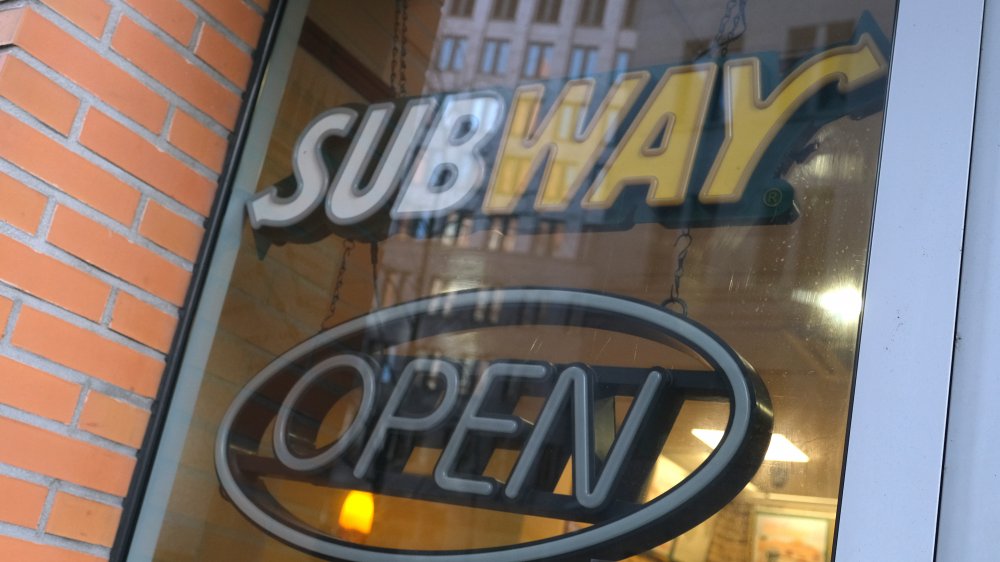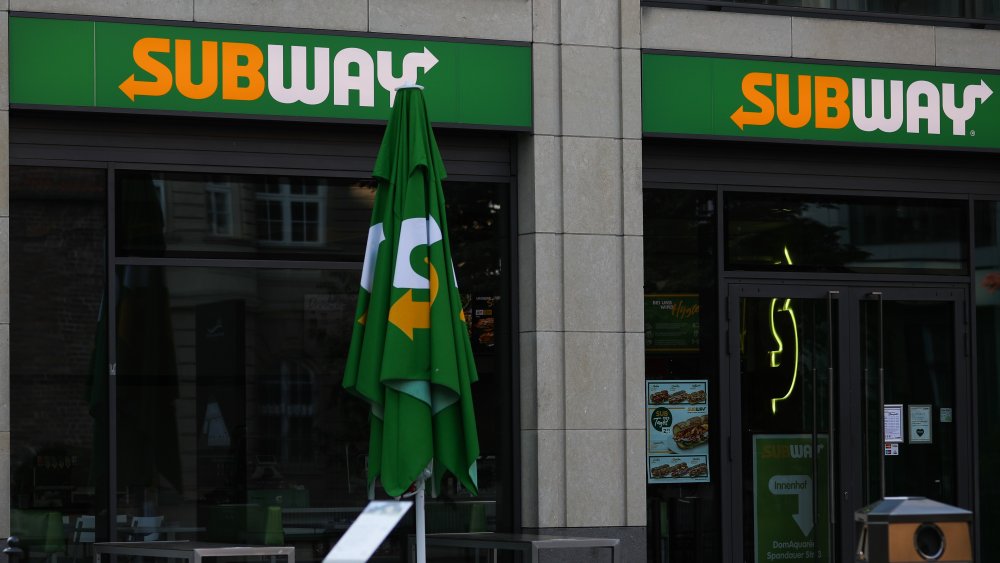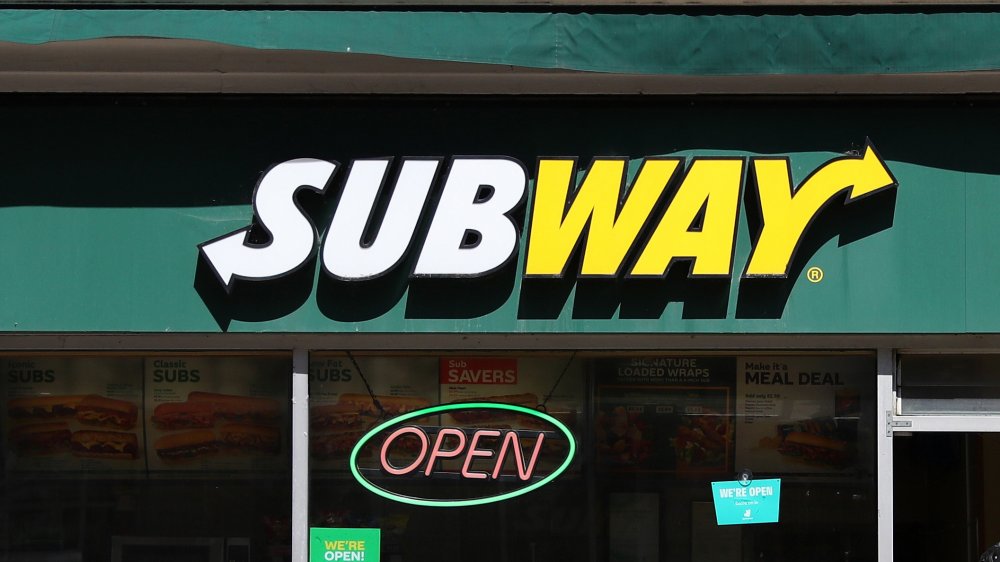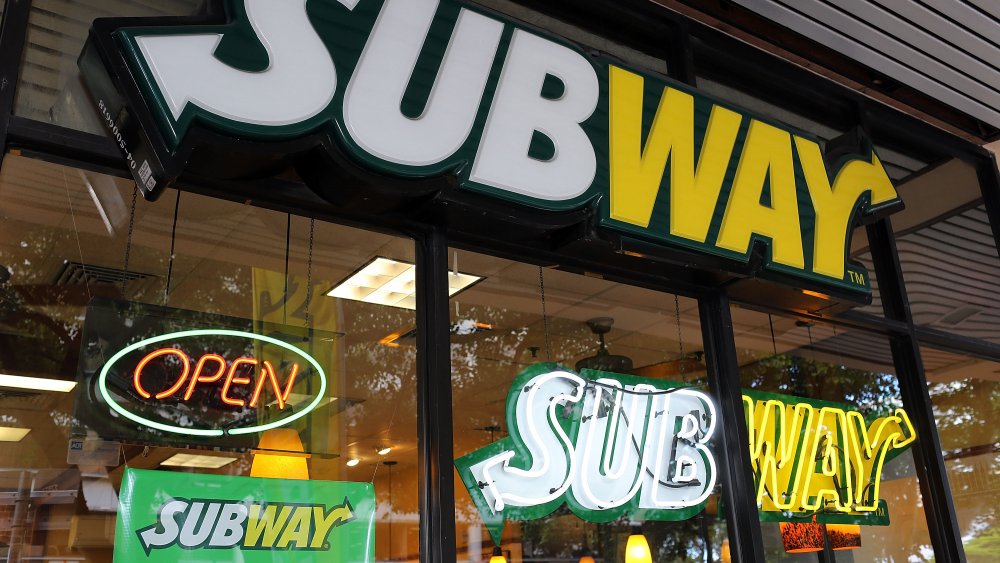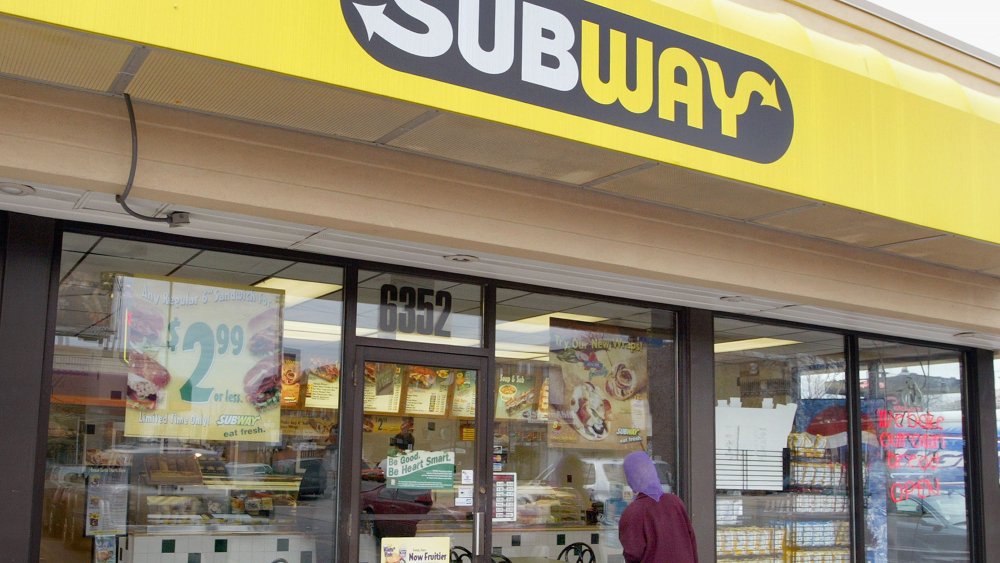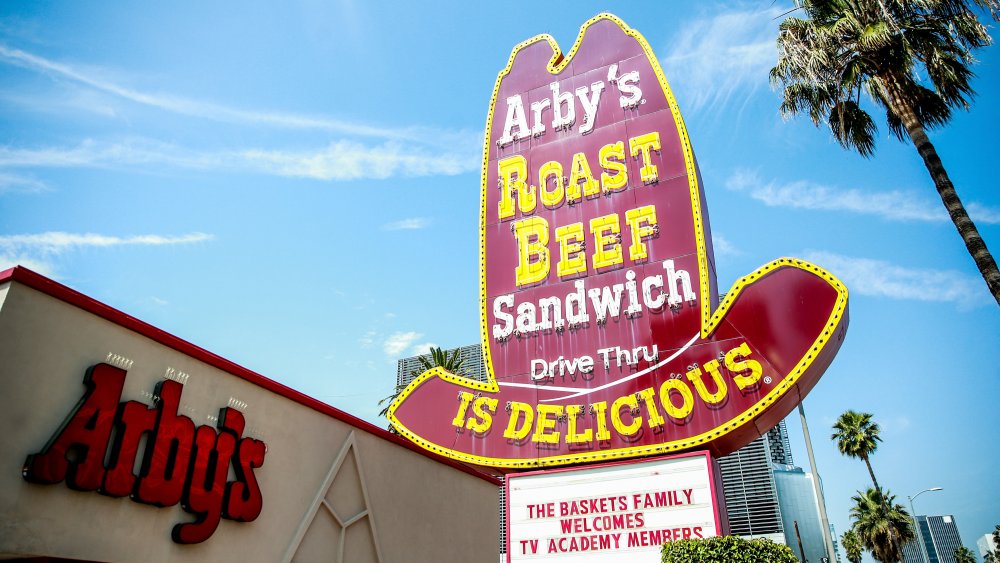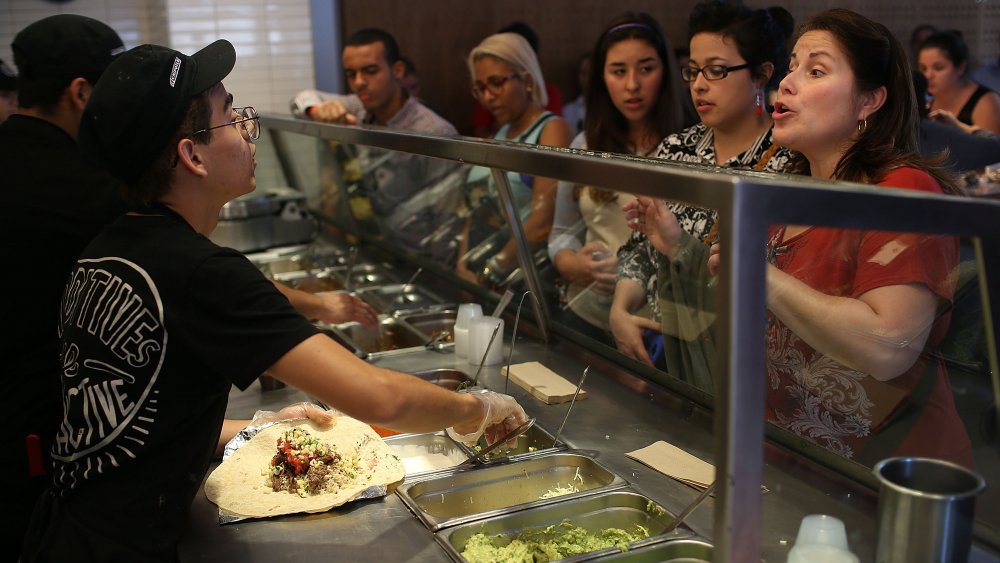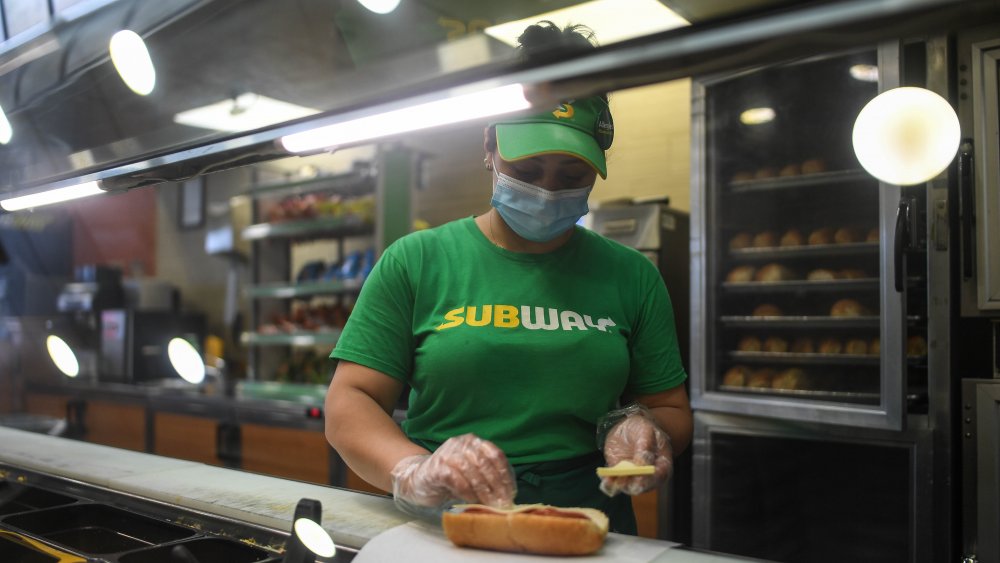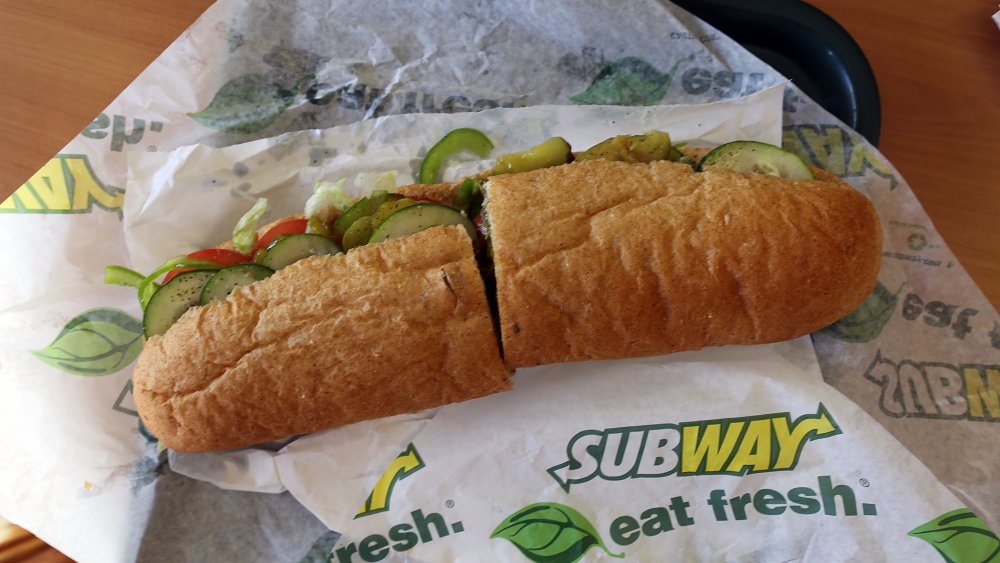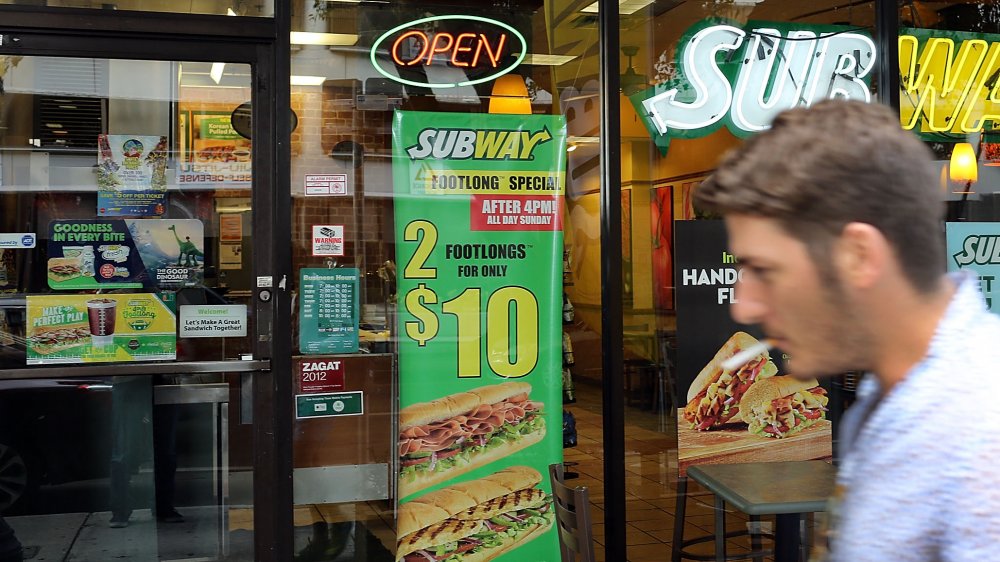Signs Subway Might Not Be Around Much Longer
With more than 41,000 locations in 100-plus countries, it's safe to assume there's probably a Subway nearby no matter where that you go. In 2019, it was the largest restaurant chain in the United States — with almost 10,000 more locations than the second largest chain, Starbucks. Numbers like that ostensibly speak of a company on solid footing with little concern of its future prospects. If only life were so rose-colored for the ubiquitous sandwich shop.
Subway's situation is trending downward and has been for some time. Once viewed as a fresh, unique, and healthy option in the quick service restaurant market, Subway has become a stale and mismanaged brand. A host of poor decisions have come to light, causing the chain to suffer some decidedly bad years. In fact, the numbers have continued to drop year over year since 2015.
But it's not just about the money for this well-known restaurant chain. From corporate chaos to growing competition, there are a host of signs that Subway's days may be numbered. These are the signs subway might not be around much longer.
Subway stores are already closing at an increasing pace
There's no sign more indicative of Subway's imminent demise than the fact that many of the restaurant's stores have already shut their doors for good. Locations are permanently closing at an alarming pace. In 2018, Subway closed more than 1,000 stores in the United States. That dropped the total number of domestic restaurants to 24,798 — the chain's lowest number of locations since 2011. And it has continued to drop even lower since then. Subway currently has roughly 22,300 locations across the country. Sure, that's still a ton of restaurants... but it's not looking good by Subway's standards.
Clearly, 2018 was not an outlier. Since reaching its peak of just over 27,100 restaurants in 2015, Subway's growth has been on the downturn. According to Restaurant Business, the company closed 359 locations in 2016 and 836 in 2017. Collectively, the restaurant chain has closed 2,305 stores since 2015.
This comes on the heels of what was an aggressive expansion in the first half of the decade. From 2010-2015, Subway's domestic restaurant total grew 28 percent. Since then, it's down nine percent.
Subway is trying to stop the bleeding
The number of Subway stores closing has gotten so bad that Subway executives have felt the need to intervene in order to stop the hemorrhaging — or at least try to stop it. In a sign that the corporate office recognized the dire times the company is living through — and the poor public perception mass closures can have on a brand — it did something it's never done before: actively try to stop locations from going dark.
Late in 2019, the company instituted new rules that required operators to complete a questionnaire and then answer to a committee before they were able to opt out of their contracts and close their stores.
It's likely that Subway doesn't believe they can actually convince many franchisees who want out of the business to change their minds and keep the doors open. But this tactic would provide Subway time to find other operators willing to take over the restaurant in question.
In the not-too-distant past, new Subway stores annually outnumbered shuttered ones. The company continued to grow, so location closures were not of much concern. Times, they are a changing for Subway.
Sales at Subway continue to fall
Subway's total revenue reached $11.9 billion in 2014. That may sound like an impressive number, but it was actually a decline of three percent from the year before. That number has fallen each year since, culminating in $10.2 billion in sales in 2019, a decrease of $210 million from the previous year. This in a year in which the United States sandwich segment actually grew.
This loss of revenue can easily be blamed — at least partially — on the fewer number of locations. Unfortunately for Subway, this doesn't tell the whole story because individual restaurants are performing worse as well. According to Nation's Restaurant News, estimated unit sales in 2012 were $482,000. By 2016, that number had dropped to $420,000 — a 15 percent decline. (For comparison, Jimmy John's, one of Subway's main competitors in the quick-serve sandwich arena, averages $772,000 per store.)
Subway takes in eight percent of each store's gross sales. If a location's sales dry up, it puts a serious dent in the company's future prospects.
Subway has seen big changes to staff at headquarters
Many of Subway's problems laid down roots years and even decades ago. But the corporate office has been in a tailspin since founder and co-owner Fred DeLuca passed away in 2015. Following his death, DeLuca's sister Suzanne Greco took over as CEO.
To say Greco's three-year stint running Subway was tumultuous would be putting it lightly. Sales continued to fall under her watch, and franchisees were revolting. "A lot of people in the industry feel that Suzanne is not qualified to be the CEO of the company," one franchisee told Business Insider at the time.
In late 2019, Subway brought in several new executives, including its chief marketing officer. In November, the company named John Chidsey as its new CEO. It only took a month for Chidsey to oversee even more changes when three top executives left the company.
It wasn't only the C-suite that experienced a shakeup. Chidsey made his presence known to the rank and file almost immediately. In February 2020, Subway laid off 300 employees at its Connecticut headquarters. That represented about 25 percent of its workforce.
Just four months later, the company slashed another 150 jobs. Subway chalked up the layoffs to an attempt to streamline and simplify the business. But if operating the company requires nearly 500 less people, there's obviously much less business to go around.
Subway has seen increased competition among sandwich restaurants
Subway isn't the only sandwich shop on the block anymore, which has made things much more difficult for the company. The restaurant concept originally found success by carving out a niche in the fast food market. There were few, if any, quick service sandwich restaurants when the company was founded in 1965. If you wanted a good sub, of course you went to Subway. They remained the preeminent sub shop for decades with few competitors posing any legitimate threat.
In recent years, though, that has all changed — a sign that things aren't looking great for the chain. The past decade has seen numerous sandwich chains flourish and take huge chunks out of Subway's market share. According to QSR Magazine, five of the 32 largest restaurant chains in the U.S. serve primarily sandwiches. Even worse for Subway, chains like Jersey Mike's, Firehouse Subs, and Arby's are taking business away from Subway. Every time a new sandwich chain experiences success, things get a little more dire for Subway.
Subway also has increased competition among quick service restaurants
But it's not only in the sandwich arena where Subway faces daunting competition. The chain was long seen as a healthier option in a fast food world filled with Big Macs and Whoppers. Several fast casual restaurant chains offering healthy menu options, such as Panera Bread and Chipotle, have risen through the ranks in recent years, and it's a bad sign for Subway.
Others haven't just caught up to Subway, they've passed them in several categories. That's in large part because the company has made little to no effort to move forward. In several categories, it has simply failed to evolve.
As customers' idea of what's healthy has also changed, Subway has been slow to adapt. Organic, GMO-free, and transparently-sourced ingredients hold more value to consumers than they once did. Simply slapping some lettuce and tomatoes on cold cuts isn't going to cut it anymore.
Subway has also lagged behind considerably with its store design. It's likely that if you walk into a Subway restaurant today, it looks almost identical to how it did a decade or two ago. While many quick serve restaurants opened visually inviting locations with features like ordering kiosks, Subway stores grew stale. The company only started redesigning its restaurants in 2017 — for the first time in 20 years — and they were probably at least a decade too late.
Subway franchisees have been unhappy for a while
Subway grew into the largest restaurant chain the world on the backs of its franchise owners. Collectively, more than 21,000 franchisees own its restaurants. These operators are usually individuals who risk a great deal opening a restaurant, as opposed to investment firms that commonly own other fast food chain locations. They've been focal about their frustrations with the chain for a while now, and unhappy owners are never a good sign for a company.
For years, Subway maintained an aggressive expansion approach, often opening new locations within walking distance of existing ones. This causes stores to compete against each other and cannibalize Subway revenue.
Franchisees have also had run-ins with Subway about its business practices. The company divides its stores into regions, each overseen by development agents, who are often location operators themselves. These development agents are in charge of inspecting locations to ensure each is in compliance. But often, they do not act in good faith. According to The New York Times, many Subway owners feel like this creates a conflict of interest. They say it's unfair to give development agents the power to close competing stores.
This has led to numerous lawsuits. In 2018, Subway found itself involved in 29 litigations per 1,000 franchisees. For comparison, McDonald's, Dunkin', Pizza Hut, Burger King and Wendy's combined for just 1.4.
All this leads to unhappy franchisees. As one told the Times, "We've been through so much, but it's not worth it anymore."
Subway has suffered multiple public embarrassments
One or two PR nightmares are par for the course for most national chains, but when those snafus just keep coming, it's a bad sign for the chain in question.
Several reputation-damaging controversies have embroiled the sandwich conglomerate, which have done nothing to improve their standing with the American eating public.
In 2017, the CBC published a report that found the chicken in Subway sandwiches contained only about 50 percent chicken DNA, saying most of the remaining half was soy. Subway went on to prove them wrong and sue for defamation, but the damage had been done.
A few years earlier, a popular food blogger, the Food Babe, launched a petition calling on Subway to remove a chemical from its bread. The ingredient, called azodicarbonamide, is commonly used in the manufacturing of yoga mats and shoe rubber. It was later revealed that the chemical is frequently used in bread products to help strengthen the dough, though Subway still removed the ingredient. But once again, the scandal had already erupted on social media.
Known as the place to "Eat Fresh," Subway customers started to think of the chain as a place that might not be as fresh — or healthy — as it seems. Just like that, one of Subway's main distinguishing characteristics is gone — and that's a bad sign for Subway.
Even Subway's promotions are failing
Subway has long been known for its $5 Footlong offer, and loyal customers have missed this amazing deal. Luckily for fans, Subway brought back an iteration of its famous $5 Footlong with a 2-for-$10 promotion in June 2020. The idea was to help drum up business during an economic downturn. But the offer got off to a disastrous start when the overwhelming majority of franchisees opposed the discount. The North American Association of Subway Franchisees (NAASF) urged operators to not participate in the promotion. "The $5 Footlong was abandoned years ago after countless attempts to make it profitable," the NAASF wrote in a letter to its members. "Not since the first iteration of this campaign did the increase in sales from traffic offset the cost of the trade-down."
Operators have long argued that it is nearly impossible to make money off the $5 Footlong offer — and doubling it to 2-for-$10 only doubles their losses. Restaurant Business calculated that it cost about $4.93 to make Subway's cheapest sub. When you add in fixed costs, owners are losing money each time they sell a $5 Footlong.
According to Restaurant Business, only 71 percent of stores offered the discount. This likely only created confusion and discontent among customers — not a good look for a business that's already struggling to bring customers in the door. Ultimately, the offer barely lasted two weeks before it scaling back to only being available on digital orders. Subway had planned on holding the $5 Footlong promotion all summer.
